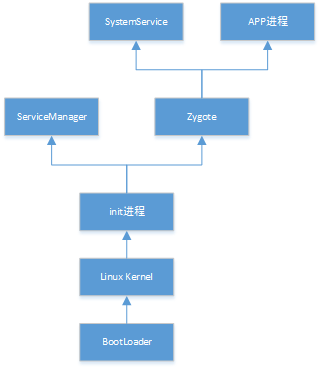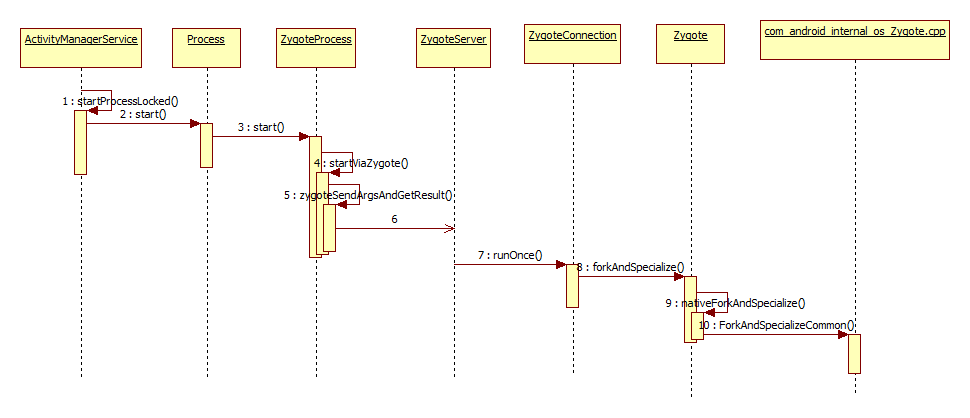目录
1.Zygote是什么:
英文直译是受精卵,Zygote进程在Android系统中是一个极其重要的守护进程服务(Daem Service),他的主要作用有以下几点:
- 启动Android框架层的进程:
Zygote首先会启动SystemService进程,而在SystemService会启动Android系统中重要服务。例如ActvityManagerService、PackageManagerService等。
- 为启动的应用程序创建一个新的进程
Zygote启动时会创建一个Socket,ActivityManagerService通过这个Socket发消息给Zygote为应用创建一个新的进程。
- 加快应用的启动速度
Zygote启动时会创建一个Dalvik VM,并在Dalvik VM上装载系统资源,这样Zygote进程Fork子进程时就会继承此虚拟机的相关资源(也就是预加载系统的资源和类),这样启动一个应用只要加载应用的相关资源即可,这样大大的提高了应用的启动速度。
2.Zygote是怎么启动的:

- BootLaoder(fastboot)系统启动的引导程序,主要功能是:关闭看门狗,初始化储存控制器,加载程序代码到内存中等
- Linux Kernel系统核心基础
- init进程,Kernel启动Android系统的第一个进程,主要负责解析init.rc并触发Action和启动服务;提供property服务管理、初始化以及以及对应的事件触发;维护系统服务等。
- Zygote进程,负责创建Dalvik VM(可以简单的理解为JVM,但Dalvik VM和JVM是完全不同的)以及创建创建Framework的系统服务,并加载相应的资源等。
3.Zygote的运行流程
Zygote进程是有init进程格局init.rc配置的Action进行启动的,而init.rc是根据编译32位/64位系统来配置选择的,配置项为
/system/core/rootdir/init.rc
import /init.${ro.zygote}.rc以init.zygote32_64.rc为例
/system/core/rootdir/init.zygote64_32.rc
service zygote /system/bin/app_process64 -Xzygote /system/bin --zygote --start-system-server --socket-name=zygote
class main
priority -20
user root
group root readproc
socket zygote stream 660 root system
onrestart write /sys/android_power/request_state wake
onrestart write /sys/power/state on
onrestart restart audioserver
onrestart restart cameraserver
onrestart restart media
onrestart restart netd
onrestart restart wificond
writepid /dev/cpuset/foreground/tasks /dev/stune/foreground/tasks /dev/blkio/foreground/tasks
critical
service zygote_secondary /system/bin/app_process32 -Xzygote /system/bin --zygote --socket-name=zygote_secondary --enable-lazy-preload
class main
priority -20
user root
group root readproc
socket zygote_secondary stream 660 root system
onrestart restart zygote
writepid /dev/cpuset/foreground/tasks /dev/stune/foreground/tasks /dev/blkio/foreground/tasks
critical
服务名称分别是zygote和zygote_secondary,分别是执行system/bin下的app_process64和app_process32这2个执行文件来启动的
/system/bin
lrwxr-xr-x 1 root shell 13 2019-05-06 04:51 app_process -> app_process64
-rwxr-xr-x 1 root shell 24988 2019-05-06 04:51 app_process32
-rwxr-xr-x 1 root shell 23960 2019-05-06 04:51 app_process64从第一个软连接可以看到,系统是64位的,同时兼容32位的,接下来看看app_process的源码
/frameworks/base/cmds/app_process/app_main.cpp
int main(int argc, char* const argv[])
{
......
//创建Dalvik VM
AppRuntime runtime(argv[0], computeArgBlockSize(argc, argv));
// Process command line arguments
// ignore argv[0]
argc--;
argv++;
// Everything up to '--' or first non '-' arg goes to the vm.
//
// The first argument after the VM args is the "parent dir", which
// is currently unused.
//
// After the parent dir, we expect one or more the following internal
// arguments :
//
// --zygote : Start in zygote mode
// --start-system-server : Start the system server.
// --application : Start in application (stand alone, non zygote) mode.
// --nice-name : The nice name for this process.
//
// For non zygote starts, these arguments will be followed by
// the main class name. All remaining arguments are passed to
// the main method of this class.
//
// For zygote starts, all remaining arguments are passed to the zygote.
// main function.
//
// Note that we must copy argument string values since we will rewrite the
// entire argument block when we apply the nice name to argv0.
//
// As an exception to the above rule, anything in "spaced commands"
// goes to the vm even though it has a space in it.
const char* spaced_commands[] = { "-cp", "-classpath" };
// Allow "spaced commands" to be succeeded by exactly 1 argument (regardless of -s).
bool known_command = false;
int i;
//从zygote.rc文件的Action中可以看出argv[0]="/system/bin"因此直接跳出循环
for (i = 0; i < argc; i++) {
if (known_command == true) {
runtime.addOption(strdup(argv[i]));
ALOGV("app_process main add known option '%s'", argv[i]);
known_command = false;
continue;
}
for (int j = 0;
j < static_cast<int>(sizeof(spaced_commands) / sizeof(spaced_commands[0]));
++j) {
if (strcmp(argv[i], spaced_commands[j]) == 0) {
known_command = true;
ALOGV("app_process main found known command '%s'", argv[i]);
}
}
if (argv[i][0] != '-') {
break;
}
if (argv[i][1] == '-' && argv[i][2] == 0) {
++i; // Skip --.
break;
}
runtime.addOption(strdup(argv[i]));
ALOGV("app_process main add option '%s'", argv[i]);
}
// Parse runtime arguments. Stop at first unrecognized option.
bool zygote = false;
bool startSystemServer = false;
bool application = false;
String8 niceName;
String8 className;
++i; // Skip unused "parent dir" argument.
while (i < argc) {
const char* arg = argv[i++];
if (strcmp(arg, "--zygote") == 0) {
zygote = true;
niceName = ZYGOTE_NICE_NAME;
} else if (strcmp(arg, "--start-system-server") == 0) {
startSystemServer = true;
} else if (strcmp(arg, "--application") == 0) {
application = true;
} else if (strncmp(arg, "--nice-name=", 12) == 0) {
niceName.setTo(arg + 12);
} else if (strncmp(arg, "--", 2) != 0) {
className.setTo(arg);
break;
} else {
--i;
break;
}
}
//到此初始化的值为:
//zygote = true; startSystemServer = true;className = "--socket-name=zygote"
Vector<String8> args;
if (!className.isEmpty()) {
// We're not in zygote mode, the only argument we need to pass
// to RuntimeInit is the application argument.
//
// The Remainder of args get passed to startup class main(). Make
// copies of them before we overwrite them with the process name.
args.add(application ? String8("application") : String8("tool"));
runtime.setClassNameAndArgs(className, argc - i, argv + i);
if (!LOG_NDEBUG) {
String8 restOfArgs;
char* const* argv_new = argv + i;
int argc_new = argc - i;
for (int k = 0; k < argc_new; ++k) {
restOfArgs.append("\"");
restOfArgs.append(argv_new[k]);
restOfArgs.append("\" ");
}
ALOGV("Class name = %s, args = %s", className.string(), restOfArgs.string());
}
} else {
// We're in zygote mode.
/*创建Dalvik VM缓存
*路径:/data/dalvik-cache/arm(支持32位)
* /data/dalvik-cache/arm64(支持64位)
*/
maybeCreateDalvikCache();
if (startSystemServer) {
args.add(String8("start-system-server"));
}
char prop[PROP_VALUE_MAX];
if (property_get(ABI_LIST_PROPERTY, prop, NULL) == 0) {
LOG_ALWAYS_FATAL("app_process: Unable to determine ABI list from property %s.",
ABI_LIST_PROPERTY);
return 11;
}
String8 abiFlag("--abi-list=");
abiFlag.append(prop);
args.add(abiFlag);
// In zygote mode, pass all remaining arguments to the zygote
// main() method.
for (; i < argc; ++i) {
args.add(String8(argv[i]));
}
}
if (!niceName.isEmpty()) {
runtime.setArgv0(niceName.string(), true /* setProcName */);
}
if (zygote) {
//开始启动ZygoteInit
runtime.start("com.android.internal.os.ZygoteInit", args, zygote);
} else if (className) {
runtime.start("com.android.internal.os.RuntimeInit", args, zygote);
} else {
fprintf(stderr, "Error: no class name or --zygote supplied.\n");
app_usage();
LOG_ALWAYS_FATAL("app_process: no class name or --zygote supplied.");
}
}在app_process服务中只要创建了一个Dalvik VM,之后根据app_process的参数列表,初始化Dalvik VM启动的类和参数,在上面AppRuntime创建了Delvik VM,AppRuntime是AndroidRuntime的子类,runtime.start方法就是调用了AndroidRuntime的start方法
/frameworks/base/core/jni/AndroidRuntime.cpp
void AndroidRuntime::start(const char* className, const Vector<String8>& options, bool zygote)
{
......
/* start the virtual machine */
/*初始化Jni/
JniInvocation jni_invocation;
jni_invocation.Init(NULL);
JNIEnv* env;
/*初始化相关参数,并且启动Java VM*/
if (startVm(&mJavaVM, &env, zygote) != 0) {
return;
}
/*回调VM启动成功*/
onVmCreated(env);
/*
* Register android functions.
*/
在VM中注册Jni相关
if (startReg(env) < 0) {
ALOGE("Unable to register all android natives\n");
return;
}
/*
* We want to call main() with a String array with arguments in it.
* At present we have two arguments, the class name and an option string.
* Create an array to hold them.
*/
//初始化jni启动Java类的相关参数
jclass stringClass;
jobjectArray strArray;
jstring classNameStr;
//创建一个java字符串,一个java字符串数组
stringClass = env->FindClass("java/lang/String");
assert(stringClass != NULL);
strArray = env->NewObjectArray(options.size() + 1, stringClass, NULL);
assert(strArray != NULL);
classNameStr = env->NewStringUTF(className);
assert(classNameStr != NULL);
//初始化java数组中的值
env->SetObjectArrayElement(strArray, 0, classNameStr);
for (size_t i = 0; i < options.size(); ++i) {
jstring optionsStr = env->NewStringUTF(options.itemAt(i).string());
assert(optionsStr != NULL);
env->SetObjectArrayElement(strArray, i + 1, optionsStr);
}
/*
* Start VM. This thread becomes the main thread of the VM, and will
* not return until the VM exits.
*/
char* slashClassName = toSlashClassName(className);
jclass startClass = env->FindClass(slashClassName);
if (startClass == NULL) {
ALOGE("JavaVM unable to locate class '%s'\n", slashClassName);
/* keep going */
} else {
jmethodID startMeth = env->GetStaticMethodID(startClass, "main",
"([Ljava/lang/String;)V");
if (startMeth == NULL) {
ALOGE("JavaVM unable to find main() in '%s'\n", className);
/* keep going */
} else {
//调用com/android/internal/os/ZygoteInit的Main方法启动 正常运行会阻塞在这
//出异常之后才会继续执行
env->CallStaticVoidMethod(startClass, startMeth, strArray);
#if 0
if (env->ExceptionCheck())
threadExitUncaughtException(env);
#endif
}
}
free(slashClassName);
ALOGD("Shutting down VM\n");
if (mJavaVM->DetachCurrentThread() != JNI_OK)
ALOGW("Warning: unable to detach main thread\n");
if (mJavaVM->DestroyJavaVM() != 0)
ALOGW("Warning: VM did not shut down cleanly\n");
}在start方法中主要就做了3件事:
- 启动VM
- 初始化Jni
- 调用ZygoteInit的main方法启动Java相关服务
继续看看ZygoteInit中做了什么
/frameworks/base/core/java/com/android/internal/os/ZygoteInit.java
public static void main(String argv[]) {
/*请参数:com.android.internal.os.ZygoteInit start-system-server --abi-list=arm64-v8a
--socket-name=zygote
com.android.internal.os.ZygoteInit --abi-list=armeabi-v7a,armeabi
--socket-name=zygote_secondary --enable-lazy-preload
*/
//注册Sockot,为接受命令Fock子进程做准备
ZygoteServer zygoteServer = new ZygoteServer();
// Mark zygote start. This ensures that thread creation will throw
// an error.
// Zygote goes into its own process group.
//设置当前进程的pid
try {
Os.setpgid(0, 0);
} catch (ErrnoException ex) {
throw new RuntimeException("Failed to setpgid(0,0)", ex);
}
try {
// Report Zygote start time to tron unless it is a runtime restart
if (!"1".equals(SystemProperties.get("sys.boot_completed"))) {
MetricsLogger.histogram(null, "boot_zygote_init",
(int) SystemClock.elapsedRealtime());
}
String bootTimeTag = Process.is64Bit() ? "Zygote64Timing" : "Zygote32Timing";
BootTimingsTraceLog bootTimingsTraceLog = new BootTimingsTraceLog(bootTimeTag,
Trace.TRACE_TAG_DALVIK);
bootTimingsTraceLog.traceBegin("ZygoteInit");
//promote process priority to boost bootup
int myPriority = Process.getThreadPriority(Process.myPid());
Process.setThreadPriority(Process.THREAD_PRIORITY_URGENT_AUDIO);
//启动DDMS
RuntimeInit.enableDdms();
// Start profiling the zygote initialization.
SamplingProfilerIntegration.start();
boolean startSystemServer = false;
String socketName = "zygote";
String abiList = null;
boolean enableLazyPreload = false;
for (int i = 1; i < argv.length; i++) {
if ("start-system-server".equals(argv[i])) {
startSystemServer = true;
isPrimaryCpuAbi = true;
} else if ("--enable-lazy-preload".equals(argv[i])) {
enableLazyPreload = true;
} else if (argv[i].startsWith(ABI_LIST_ARG)) {
abiList = argv[i].substring(ABI_LIST_ARG.length());
} else if (argv[i].startsWith(SOCKET_NAME_ARG)) {
socketName = argv[i].substring(SOCKET_NAME_ARG.length());
} else {
throw new RuntimeException("Unknown command line argument: " + argv[i]);
}
}
if (abiList == null) {
throw new RuntimeException("No ABI list supplied.");
}
//将app_process的Socket注册到zygoteServer中
zygoteServer.registerServerSocket(socketName);
// In some configurations, we avoid preloading resources and classes eagerly.
// In such cases, we will preload things prior to our first fork.
if (!enableLazyPreload) {
bootTimingsTraceLog.traceBegin("ZygotePreload");
EventLog.writeEvent(LOG_BOOT_PROGRESS_PRELOAD_START,
SystemClock.uptimeMillis());
Jlog.d(JlogConstants.JLID_BOOT_PROGRESS_PRELOAD_START,"JL_BOOT_PROGRESS_PRELOAD_START:" + argv[0]);
//加载常用类
preload(bootTimingsTraceLog);
EventLog.writeEvent(LOG_BOOT_PROGRESS_PRELOAD_END,
SystemClock.uptimeMillis());
bootTimingsTraceLog.traceEnd(); // ZygotePreload
Jlog.d(JlogConstants.JLID_BOOT_PROGRESS_PRELOAD_END,"JL_BOOT_PROGRESS_PRELOAD_END");
} else {
Zygote.resetNicePriority();
}
// Finish profiling the zygote initialization.
SamplingProfilerIntegration.writeZygoteSnapshot();
// Do an initial gc to clean up after startup
bootTimingsTraceLog.traceBegin("PostZygoteInitGC");
gcAndFinalize();
bootTimingsTraceLog.traceEnd(); // PostZygoteInitGC
bootTimingsTraceLog.traceEnd(); // ZygoteInit
// Disable tracing so that forked processes do not inherit stale tracing tags from
// Zygote.
Trace.setTracingEnabled(false);
//Restore process priority
Process.setThreadPriority(myPriority);
// Zygote process unmounts root storage spaces.
Zygote.nativeUnmountStorageOnInit();
// Set seccomp policy
Seccomp.setPolicy();
//启动framework层系统服务
if (startSystemServer) {
startSystemServer(abiList, socketName, zygoteServer);
}
Log.i(TAG, "Accepting command socket connections, abiList= "+abiList);
//阻塞循环等待命令
zygoteServer.runSelectLoop(abiList);
zygoteServer.closeServerSocket();
} catch (Zygote.MethodAndArgsCaller caller) {
caller.run();
} catch (Throwable ex) {
Log.e(TAG, "System zygote died with exception", ex);
zygoteServer.closeServerSocket();
throw ex;
}
}
到此Zygote的启动流程就结束了,最重要的就是启动VM、加载framework层的系统服务和初始化Sokect通道(启动APP需要使用)。
4.Fork进程流程:
Zygote启动后Fork的第一个进程就是SystemService,可以看上面代码中启动framework层系统服务。
./frameworks/base/core/java/com/android/internal/os/ZygoteInit.java
/**
* Prepare the arguments and fork for the system server process.
*/
private static boolean startSystemServer(String abiList, String socketName, ZygoteServer zygoteServer)
throws Zygote.MethodAndArgsCaller, RuntimeException {
long capabilities = posixCapabilitiesAsBits(
OsConstants.CAP_IPC_LOCK,
OsConstants.CAP_KILL,
OsConstants.CAP_NET_ADMIN,
OsConstants.CAP_NET_BIND_SERVICE,
OsConstants.CAP_NET_BROADCAST,
OsConstants.CAP_NET_RAW,
OsConstants.CAP_SYS_MODULE,
OsConstants.CAP_SYS_NICE,
OsConstants.CAP_SYS_PTRACE,
OsConstants.CAP_SYS_TIME,
OsConstants.CAP_SYS_TTY_CONFIG,
OsConstants.CAP_WAKE_ALARM
);
/* Containers run without this capability, so avoid setting it in that case */
if (!SystemProperties.getBoolean(PROPERTY_RUNNING_IN_CONTAINER, false)) {
capabilities |= posixCapabilitiesAsBits(OsConstants.CAP_BLOCK_SUSPEND);
}
/* Hardcoded command line to start the system server */
String args[] = {
"--setuid=1000",
"--setgid=1000",
"--setgroups=1001,1002,1003,1004,1005,1006,1007,1008,1009,1010,1018,1021,1023,1032,3001,3002,3003,3006,3007,3009,3010",
"--capabilities=" + capabilities + "," + capabilities,
"--nice-name=system_server",
"--runtime-args",
"com.android.server.SystemServer",
};
ZygoteConnection.Arguments parsedArgs = null;
int pid;
try {
//创建Arguments对象,初始化启动参数
parsedArgs = new ZygoteConnection.Arguments(args);
//根据系统属性ro.debuggable来初始化Debuggger
ZygoteConnection.applyDebuggerSystemProperty(parsedArgs);
//初始化invoke-with参数
ZygoteConnection.applyInvokeWithSystemProperty(parsedArgs);
/* Request to fork the system server process */
//调用jni方法fork进程
pid = Zygote.forkSystemServer(
parsedArgs.uid, parsedArgs.gid,
parsedArgs.gids,
parsedArgs.debugFlags,
null,
parsedArgs.permittedCapabilities,
parsedArgs.effectiveCapabilities);
} catch (IllegalArgumentException ex) {
throw new RuntimeException(ex);
}
/* For child process */
if (pid == 0) {
if (hasSecondZygote(abiList)) {
waitForSecondaryZygote(socketName);
}
zygoteServer.closeServerSocket();
handleSystemServerProcess(parsedArgs);
}
return true;
}
调用nativeForkSystemServer方法com_android_internal_os_Zygote_nativeForkSystemServer方法
/frameworks/base/core/jni/com_android_internal_os_Zygote.cpp
static jint com_android_internal_os_Zygote_nativeForkSystemServer(
JNIEnv* env, jclass, uid_t uid, gid_t gid, jintArray gids,
jint debug_flags, jobjectArray rlimits, jlong permittedCapabilities,
jlong effectiveCapabilities) {
pid_t pid = ForkAndSpecializeCommon(env, uid, gid, gids,
debug_flags, rlimits,
permittedCapabilities, effectiveCapabilities,
MOUNT_EXTERNAL_DEFAULT, NULL, NULL, true, NULL,
NULL, NULL, NULL);
......
return pid;
}
// Utility routine to fork zygote and specialize the child process.
static pid_t ForkAndSpecializeCommon(JNIEnv* env, uid_t uid, gid_t gid, jintArray javaGids,
jint debug_flags, jobjectArray javaRlimits,
jlong permittedCapabilities, jlong effectiveCapabilities,
jint mount_external,
jstring java_se_info, jstring java_se_name,
bool is_system_server, jintArray fdsToClose,
jintArray fdsToIgnore,
jstring instructionSet, jstring dataDir) {
// Temporarily block SIGCHLD during forks. The SIGCHLD handler might
// log, which would result in the logging FDs we close being reopened.
// This would cause failures because the FDs are not whitelisted.
//
// Note that the zygote process is single threaded at this point.
if (sigprocmask(SIG_BLOCK, &sigchld, nullptr) == -1) {
ALOGE("sigprocmask(SIG_SETMASK, { SIGCHLD }) failed: %s", strerror(errno));
RuntimeAbort(env, __LINE__, "Call to sigprocmask(SIG_BLOCK, { SIGCHLD }) failed.");
}
//调用linux的fork方法进行进程创建
pid_t pid = fork();
//此时会返回2个pid pid为0时此时运行的是子进程中,
//pid大于0时返回的是子进程的pid,此时运行在父进程中
if (pid == 0) {
......
//挂载私有目录,准备私用资源等以及一些其他操作
} else if (pid > 0) {
// the parent process
// We blocked SIGCHLD prior to a fork, we unblock it here.
if (sigprocmask(SIG_UNBLOCK, &sigchld, nullptr) == -1) {
ALOGE("sigprocmask(SIG_SETMASK, { SIGCHLD }) failed: %s", strerror(errno));
RuntimeAbort(env, __LINE__, "Call to sigprocmask(SIG_UNBLOCK, { SIGCHLD }) failed.");
}
}
return pid;
}
} // anonymous namespace在调用fork()方法之前,暂时阻止SIGCHLD信号量,fork完成之后在恢复
在语句pid=fork()之前,只有一个进程在执行这段代码,但在这条语句之后,就变成两个进程在执行了,这两个进程的几乎完全相同,将要执行的下一条语句都是if(pid<0)……
为什么两个进程的fpid不同呢,这与fork函数的特性有关。fork调用的一个奇妙之处就是它仅仅被调用一次,却能够返回两次,它可能有三种不同的返回值:
1)在父进程中,fork返回新创建子进程的进程ID;
2)在子进程中,fork返回0;
3)如果出现错误,fork返回一个负值;
5.APP的Fork进程过程:

AMS中调用startProcessLocked之后在ZygoteProcess中初始化参数,之后通过Socket发消息给ZygoteService中,在ZygoteConnection中解析参数,并初始化,之后调用Jni方法,最后调用Linux的Fork方法新建一个子进程。






















 503
503











 被折叠的 条评论
为什么被折叠?
被折叠的 条评论
为什么被折叠?








